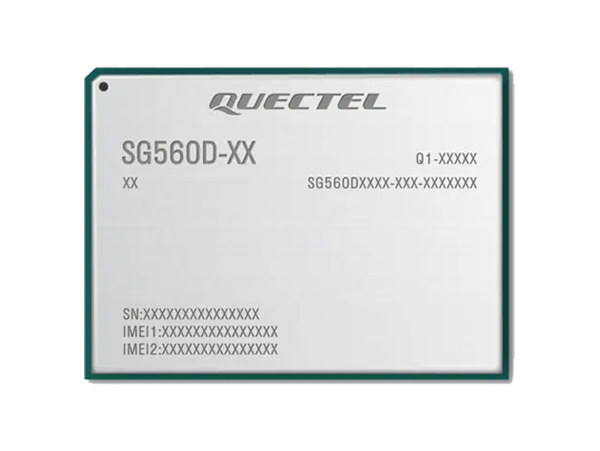Quectel SG560D is a 5G Sub-6GHz & WiFi 6E module for AIoT applications that runs Android 12 on a Qualcomm QCM6490 SoC with an octa-core Kryo 670 64-bit Arm CPU and a Qualcomm Adreno 643L GPU.
The SG560D module is equipped with 4GB LPDDR4X RAM and 64GB UFS storage by default, supports up to 2520×1080 MIPI display at a refresh rate of 144Hz, and can deliver up to 14 TOPS for AI inference.
Quectel SG560D key features and specifications:
- SoC – Qualcomm QCM6490 octa-core processor with one Kryo 670 Gold plus high-performance core up to 2.7 GHz, 3x Kryo Gold cores at 2.4 GHz, 4x Kryo Silver low-power cores @ 1.9 GHz, Adreno 643L GPU, 6th gen AI Engine delivering up to 14 TOPS, up to 4Kp30 H.265/H.264 video encode, 4Kp60 video decode; 6nm process.
- System Memory – 4GB LPDDR4X by default
- Storage – 64GB UFS flash by default
- Display – MIPI DSI interface up to 2520×1080 @ 144 Hz; touch panel interface
- Wireless connectivity
- Cellular
- 5G sub-6GHz support, backward compatible with global 4G LTE and 3G WCDMA networks
- 5G standalone (SA) and non-standalone (NSA)
- 4×4 MIMO download, 2×2 MIMO uplink
- Max. downlink: 2.5Gbps
- Max. uplink: 900Mbps
- Wi-Fi – WiFi 6E bands of 2.4 GHz, 5 GHz and 6 GHz, dual-band simultaneous (DBS), Wi-Fi 2×2 MU-MIMO
- Bluetooth – Bluetooth 5.2
- GNSS – GPS, GLONASS, BDS, NavIC, Galileo, QZSS, SBAS
- Multi-region variants with
- SG560D-EU for EMEA
- SG560D-NA for North America
- SG560D-CN for China
- SG560D-WF for worldwide use
- Cellular
- Peripherals – 2x USB, multiple PCIe, UART, I2S, SPI, LCM, camera, etc…
- Dimensions – 56.5 x 42.5 x 2.95mm (LGA module)
- Weight – 17.5 grams
- Temperature Range – -35°C to +75°C
While Quectel SG520D currently runs Android 12, the company promised a long life span with availability at least until 2028, and the module should get future upgrades for Android 13, Android 14, and Android 15. It is suitable for M2M and AIoT applications ranging from video conferencing systems, live streaming devices, gaming, robots, drones, AR/VR, and intelligent retail smart gateways and CPEs.
The 5G & WiFi 6E module was announced at Embedded World 2022, but the company did not provide availability and pricing information. More details may be found on the product page and press release.
Thanks to TLS for the tip.

Jean-Luc started CNX Software in 2010 as a part-time endeavor, before quitting his job as a software engineering manager, and starting to write daily news, and reviews full time later in 2011.
Support CNX Software! Donate via cryptocurrencies, become a Patron on Patreon, or purchase goods on Amazon or Aliexpress





Kryo 670 Gold is Coretex A78, and Silver is A55. So this is on par with Fall 2020 flagship phones. I’d love to see a Chromebook made with this chip, with a 13.3″ 1440×900 display, 22Wh battery, mobile data, SD/USB A/USB C PD charging and DisplayPort Alternate mode, <2.5lb. FHD displays are pointless on 13.3″ devices, let alone cellphones. They just eat battery by being both less energy efficient for the same brightness, and requiring scaled-up desktop/applications/sites, and the scaling often reduced fidelity vs native with sub-pixel rendering. Retina displays really only serve one purpose: to enable 10-bit colour depths… Read more »
Weird rant on screens. No, people can want 1920×1080 in 13.3″. I even see complaints about 1366×768 in 11.6″.
I’m just saying that almost every user of a 1920×1080 13.3″ screen will end up using non-native scaling of their apps and websites, and end up with worse visual fidelity and worse battery life as a result. For example Windows will default to 1.25% scaling on such a machine. There’s a small handful of people who need to actually run software that doesn’t function well at below FHD resolution, like Sage Accounting, on those small screen devices. The Venn Diagram of those people, and the people with the visual acuity to do that work on such a small screen is… Read more »
Besides the nonsense of the screen resolutions.
How should a laptop benefit anyone without mainline linux? It will at best be an Android tablet with keyboard. Or a laptop running Android with a crippled linux user space…
That’s why I said Chromebook. Crostini / Crouton get you the full Linux application ecosystem. Google’s kernel doesn’t support various fancy USB devices – that’s the main drawback. Mainline isn’t quite the problem it was. Most manufacturers support EFI boot in developer mode, public devicetrees appear pretty quickly now, and Vulkan for Mali is progressing well.
You will be able to get a laptop with this chip, actually. QCx6490 is an IOT spinoff (or, more precisely, a rebrand with tiny changes to the fusing configuration – the silicon is the same) of Qualcomm’s Snap 778, which was also rebranded as 7c Gen 3, a chip that will come to Chromebooks (and WoS devices) later this year.
TY for that!
I think Mediatek has a similar octa core A78 / A55 family of SoCs. mt8195 is supposedly coming to Chromebooks soonish.
Dimensity 1200 yeah, and it’s even a bit up-spec vs the Qualcomm part.
Nothing interesting as long as Q is doing the same problematic schtik it has been doing since Zeebo days.